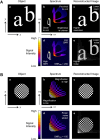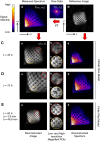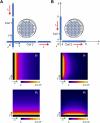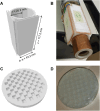Use of nonlinear pulsed magnetic fields for spatial encoding in magnetic resonance imaging
- PMID: 38553559
- PMCID: PMC10980706
- DOI: 10.1038/s41598-024-58229-x
Use of nonlinear pulsed magnetic fields for spatial encoding in magnetic resonance imaging
Abstract
This study examines the use of nonlinear magnetic field coils for spatial encoding in magnetic resonance imaging. Existing theories on imaging with such coils share a complex reconstruction process that originates from a suboptimal signal interpretation in the spatial-frequency domain (k-space). In this study, a new solution to this problem is proposed, namely a two-step reconstruction process, in which in the first step, the image signal is converted into a frequency spectrum, and in the second step, the spectrum, which represents the distorted image, is geometrically and intensity corrected to obtain an undistorted image. This theory has been verified by numerical simulations and experimentally using a straight wire as a coil model for an extremely nonlinear magnetic field. The results of this study facilitate the use of simple encoding coil designs that can feature low inductance, allowing for much faster switching times and higher magnetic field gradients.
© 2024. The Author(s).
Conflict of interest statement
The authors declare no competing interests.
Figures






Similar articles
-
Single-shot imaging with higher-dimensional encoding using magnetic field monitoring and concomitant field correction.Magn Reson Med. 2015 Mar;73(3):1340-57. doi: 10.1002/mrm.25235. Epub 2014 Mar 31. Magn Reson Med. 2015. PMID: 24687529
-
Concept for gradient-free MRI on twin natural slices.MAGMA. 2023 Aug;36(4):671-686. doi: 10.1007/s10334-022-01047-x. Epub 2022 Nov 22. MAGMA. 2023. PMID: 36417013
-
PexLoc-Parallel excitation using local encoding magnetic fields with nonlinear and nonbijective spatial profiles.Magn Reson Med. 2013 Nov;70(5):1220-8. doi: 10.1002/mrm.24559. Epub 2012 Nov 30. Magn Reson Med. 2013. PMID: 23203228
-
Local field of view imaging for alias-free undersampling with nonlinear spatial encoding magnetic fields.Magn Reson Med. 2014 Mar;71(3):1002-14. doi: 10.1002/mrm.24754. Magn Reson Med. 2014. PMID: 23649975
-
Radiofrequency coils for magnetic resonance applications: theory, design, and evaluation.Crit Rev Biomed Eng. 2014;42(2):109-35. doi: 10.1615/critrevbiomedeng.2014011482. Crit Rev Biomed Eng. 2014. PMID: 25403875 Review.
References
-
- Stejskal EO, Tanner JE. Spin diffusion measurements: Spin echoes in the presence of a time-dependent field gradient. J. Chem. Phys. 1965;42:288–292. doi: 10.1063/1.1695690. - DOI
-
- Tanner JE. Use of stimulated echo in nmr-diffusion studies. J. Chem. Phys. 1970;52:2523–2526. doi: 10.1063/1.1673336. - DOI
-
- Zupančič I. Current shims for high-resolution nuclear magnetic resonance on the problem of correcting magnetic field inhomogeneities. J. Sci. Instrum. 1962;39:621–624. doi: 10.1088/0950-7671/39/12/331. - DOI
Grants and funding
LinkOut - more resources
Full Text Sources

